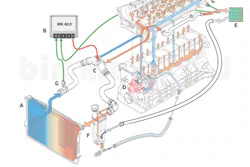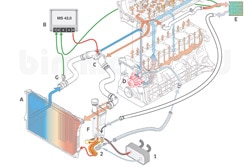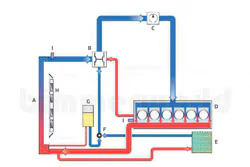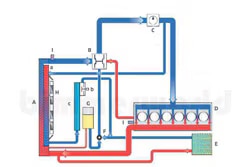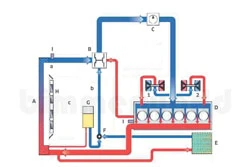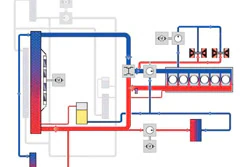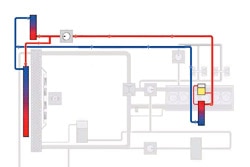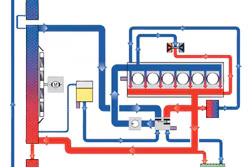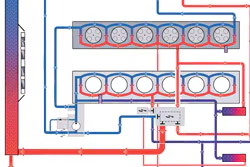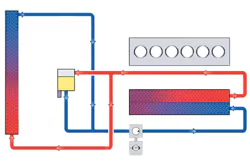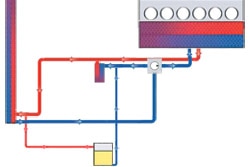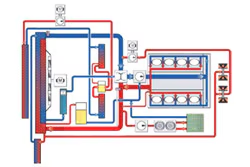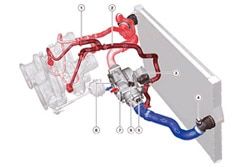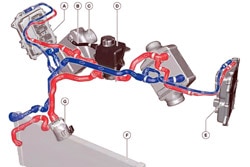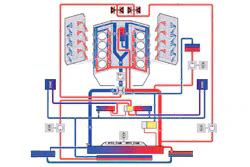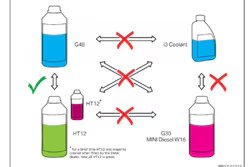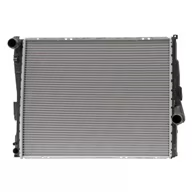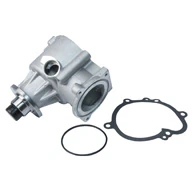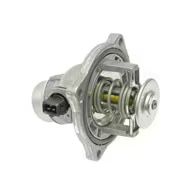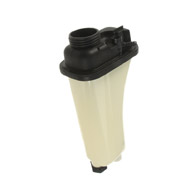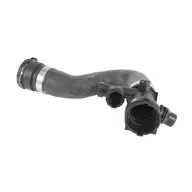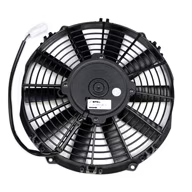|
BMW Cooling Systems
Internal combustion engines rely on a cooling system to regulate the engine temperature as well as provide heat for the climate control system (HVAC) and the mechanics of it hasn't changed in 120-odd years. BMW systems are not much different than any other car but we created this page to educate all BMW owners on how the system works and address specific problem areas unique to BMWs that any owner should be aware of.
Over time, cooling systems have become more sophisticated and complex but the core components haven't really changed:
- Cooling/heat-absorbing fluid composed of mono-ethylene glycol, combined with distilled water.
- Water Pump to circulate the coolant mix through the engine block, sub-components, and maintain pressure. Some systems use a smaller secondary pump to deliver coolant to other systems.
- Thermostat to control the coolant temp.
- Radiator that uses airflow to lower the coolant temperature.
- Heat management systems to prevent overheating (aka a radiator fan).
- Expansion overflow tank that helps regulate the coolant level throughout the system.
- Hoses that carry coolant from one component to another.
In essence, the cooling system uses a robust anti-boil/anti-freeze chemical mix that absorbs heat in the engine, circulates the heated fluid to the radiator for cooling, and then runs the cooled fluid back through the engine. Additional sub-systems like the heater core, turbochargers, and oil coolers are tied in with the main engine cooling system or have their own dedicated sub-systems.
BMW Cooling System Fundamentals
The engine, hoses, radiator, and expansion tank are filled with coolant mixture. On a BMW this is a mix of monoethylene glycol and distilled water. The water pump circulates the coolant and keeps the system pressurized. Starting from the pump, coolant enters the engine block and cylinder head to regulate internal temperatures. When hot coolant leaves the engine block it is split into two directions: to the thermostat or to the heater core to heat your interior. Flow through the radiator is controlled by the thermostat. Depending on coolant temp, the thermostat will be either closed or partially open. When closed coolant flow through the radiator is stopped and hot coolant will flow from the engine block to the thermostat and back through the water pump where it will re-enter the engine. When the thermostat is open, radiator flow resumes and cooled coolant enters the thermostat, mixes with the hot coolant, and then continues onto the water pump. Once the coolant temp is lowered the thermostat closes again. The expansion tank holds overflow and extra fluid to be used to supplement fluid being used elsewhere, such as for the heater core or for an oil cooler.
Older models have two phases of operation: warm-up and regular. During the warm-up phase the thermostat is closed, which allows coolant to circulate through the engine again and bring the engine up to operating temp sooner. Once in regular mode the thermostat will open partially to regulate coolant temp. More modern BMWs have a plethora of operating modes to meet various cooling goals. They use sophisticated electronics to control the operation of the thermostat and water pump to oversee internal engine and accessory temps.
On modern BMWs there are multiple cooling "circuits" dedicated to specific components. In addition to the traditional engine circuit there are now separate systems for the turbocharger(s), charge air intake manifold, transmission oil, and the HVAC. Each of these may have its own cooling circuit with a dedicated water pump, hoses, and even its own radiator. In some cases the system is totally self-contained while others may mix with another system. For example, the B46 330i/430i/530i turbo and HVAC systems are mixed while the intake charged air cooler is completely separate. Looking at the mess of hoses under the hood you may be looking at more than one cooling system.
Few vehicle systems will leave you stranded on the side of the road but the cooling system is certainly near the top of the list. Regular and preventative maintenance is crucial. Cooling systems break down and fail when regular service is ignored, regardless of the materials or quality of components. There is almost always a tell-tale sign of impending cooling system failure so do yourself a favor and address any warning signs ASAP.
This page is laid out by component rather than by car because the same principles apply regardless of year or generation. We have identified any problem areas below as well.
BMW Coolant
BMW prefers a specific coolant blend for all of their cars that is compatible with the extensive use of aluminum, magnesium, and plastic found in BMW engines. Since BMW calls for a specific formula (G48 or HT12, see below) there are very few alternative brands on the market. Buying an off-the-shelf coolant from an auto parts store will likely be incorrect for your BMW unless the label specifically says it's BMW compatible. Don't go by just the color alone! In addition to the Genuine BMW we also offer Red Line, Rowe Hightec, and Fuchs Maintain Fricofin. The Genuine is the most popular even though some others offer a higher boiling point than Original BMW.
BMW coolant has traditionally been light blue in color (G48 formula). In 2018 BMW announced a new coolant formula that is green in color (HT12). The new BMW HT12 green coolant is backwards compatible with older models and the two can be mixed. It has many of the same properties and boiling points but includes a silicate additive that coats metal surfaces to prevent contamination. However, the silicate coating breaks down over time so the new green coolant must be replaced every two years. The blue coolant used other coating additives that lasted longer but are not environmentally-friendly.
BMW recommends the coolant be mixed with distilled water. Why do they insist on distilled water? The water goes through multimedia particulate and charcoal filters and is then distilled. The water is vaporized into pure water and then bottled. All other minerals are left behind. This avoids any contamination that might occur with the additives and chemicals from regular tap water. BMW recommends a mix of 50:50 but this can vary depending on temperature requirements. Note that many racing organizations do not allow coolant at all because spills or leaks on the track are difficult and time consuming to clean up and large coolant spills are slippery.
Coolant also has the job of lubricating the water pump. If you feel coolant between your fingers it has a lubricity to it. This gives the moving parts of the water pump some lubrication that straight water will not.
Red Line Water Wetter is a non-glycol lubricant and corrosion inhibitor that is allowed in most racing series. It can be mixed with distilled water to give better lubrication or used in conjunction with coolant. It's also specifically designed to reduce cylinder head temperatures and reduce the potential for knock/pinging due to high temps.
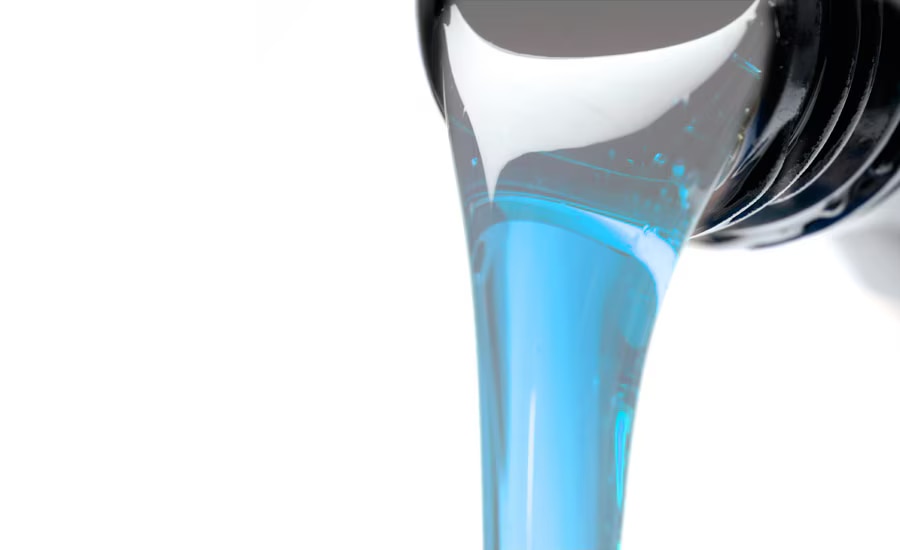
BMW Water Pump
The water pump is centrally located in the engine and is either mechanical or electric, depending on the generation. Nearly all BMWs from 2006-2018 use an electric pump. Previous to 2006 and many post-2018 are belt-driven pumps. More on this in a minute.
The pump works like a water mill - the blades of the pump (impeller) scoop up coolant and push it through the system. Most pumps are located at the front center of the engine with direct access to the engine block and cylinder head. A hose connects it to the thermostat. Mechanical pumps are working all the time while electrical pumps were programmed to work only when needed, determined by logic built in to the engine computer. Overall, BMW water pumps have been quite reliable with a few infamous exceptions:
1992-1995 M50 6-cylinder. This mechanical pump used plastic for its spinning impeller for the first time. The plastic blades would break apart, leaving nothing to scoop up the coolant. The failure happened without warning and left quite a few people stranded. BMW moved quickly by reverting to a metal impeller pump while they figured out the plastics issue. By 1998 they had re-released the pump with a composite impeller that has been ultra-reliable ever since. Some people prefer the reassurance of a metal impeller and the aftermarket continues to offer it (but unnecessary as far as we're concerned). A Stewart Components performance water pump is also available with more flow and stainless steel materials.
2006-2013 N52/N54 6-cylinder. This was BMW's first electric water pump. Switching to electric offered many advantages - less wear and tear on belts, simplified the belt and pulley system, better fuel economy due to less parasitic drag, and cooling could come under electronic control. The pump is mounted on the side of the engine block. The problem with this electric design is that the internal electrical components fail without any warning. Ironically, one compelling theory is they fail due to heat! There is no fix other than total replacement of the pump. If someone could come up with an improved circuit board or make it serviceable they would make a small fortune. It's this unresolved failure that ruined an otherwise innovative design upgrade. If your electric water pump has more than 60,000 miles you're on borrowed time and a failure could happen at any moment.
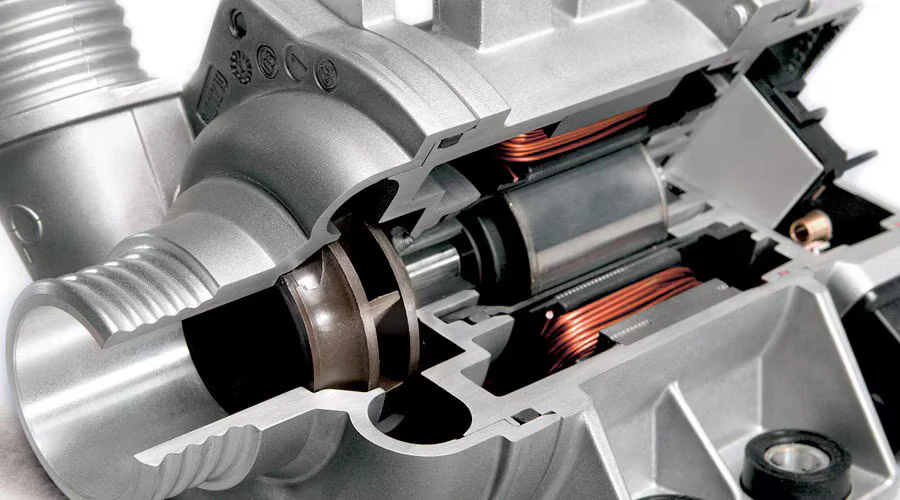
The sudden failures of electric water pumps, with no clear explanation, and lack of a long-term permanent resolution seems to have led BMW to abandon electric pumps for some 2019-on new models. The latest G20 3-series and B58TU engine have reverted to a mechanical water pump paired with a Heat Management Module with extensive cooling responsibilities.
BMW Thermostat
The thermostat regulates the temperature of the coolant - allowing hot coolant to circulate or mixing in some cooled coolant to lower the overall temperature, depending on need. When the engine is cold, or you turn your heater on, the thermostat will be closed, forcing the coolant to circulate back through the hot engine. When the coolant gets to a certain hot temperature the thermostat will open and coolant from the radiator is allowed to enter the system. Keeping the thermostat closed will help the engine heat up faster (reducing emissions or improving performance) while having a open thermostat will lead to engine temperatures being too low.
Older thermostats were unbelievable simple: a spring-loaded diaphragm sealed against a metal ring with wax. As temps and pressures rise the diaphragm will open against the wax seal and coolant would flow. Later thermostats are electrically controlled to better manage engine temp. Don't think of the thermostat as one single door, either open or closed. It's more like cars merging on a highway. With no new cars traffic moves freely and quickly (hot coolant). On-ramps allow new cars to enter the highway which slows the speeds down (cooled coolant). This analogy works better if there is a stoplight on the on ramp.
In many cases the thermostat is located in close proximity to the water pump so changing one usually means changing both.
BMW Radiator
The radiator (and its shell) used to be the most recognizable styling feature on a car because it sat front and center to maximize surface area to air flow. Even though the radiator is now tucked within the bodywork and all but invisible its principles of operation remain unchanged. Even though there is some "radiant" heat the radiator uses convection cooling - hot coolant comes in one end, is passed through tiny tubes in the core that are exposed to air flow, and cooled fluid exits out the other end. On later models (2006+) the car can have multiple auxiliary radiators supporting different systems and cooling demands. For example, the transmission oil may be cooled by a dedicated radiator or the intake air will pass through a heat exchanger supplied by an auxiliary radiator.
Most BMW radiators use an aluminum core with tiny tubes for coolant flow. Aluminum strips, also known as fins, are then woven between each tube to direct air flow. Nearly all factory BMW radiators are known as single-pass designs - the fluid moves from one side to the other. More advanced designs use a double or even a triple-pass layout where coolant criss-crosses the core for longer exposure to cooling air. Radiator cores themselves are quite robust and rarely the source of cooling problems unless damaged by debris or wear and tear after high mileage. For track and race cars we advise cleaning the debris and klag from the radiator(s) to help improve air flow. It's standard practice in our race shop to clear radiators at least between races - or sometimes more frequently - and we generally see a modest temperature improvement with each cleaning.
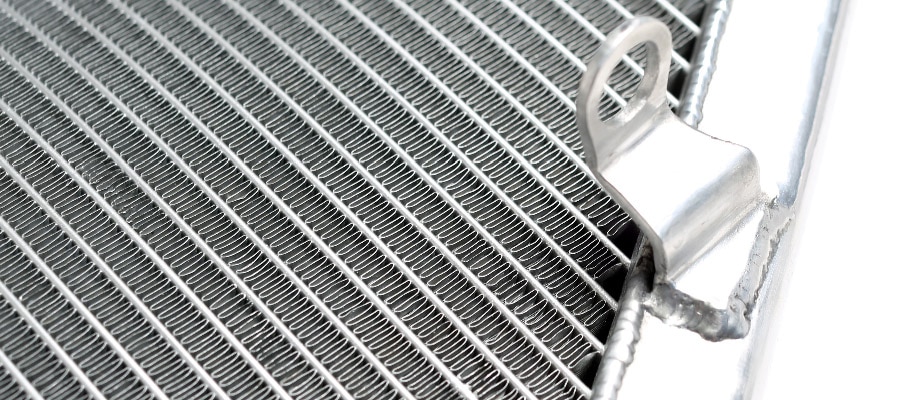
BMW radiator problems usually stem from the plastic used for the end tanks and hose connections. Over time and with exposure these tanks will develop cracks and leaks. It may take several years but it's only a matter of time before this plastic fails. Depending on your needs you can replace it with another OEM-type plastic design or upgrade to an all-aluminum design. Note that OEM radiators will perform just like the original and with the same expectations of performance and longevity. High priced aluminum radiators are typically better and go through extensive testing and quality control. However, cheap aluminum may be inferior and leave you with more regrets than benefits.
It's important to note the differences between a radiator and a heat exchanger. They both have similar jobs and sometimes are interchanged in conversation. The radiator uses convection cooling by air flow to cool the fluid mixture (water:air). The heat exchanger uses fluid to cool something else (usually intake air or oil) and is dependent on an auxiliary radiator to supply the cooling fluid. There are two common applications of heat exchangers in BMWs: oil cooling and intake air cooling. BMW will often use the term heat exchanger when they really mean radiator. It seems that they want to differentiate the engine cooling radiator from a radiator used for another system (intake air or oil cooling).
Oil heat exchangers have taken the place of traditional oil:air coolers and are used for engine or transmission oil cooling on a number of models. They are more compact and can be located anywhere in the engine bay as they don't need to be in the air flow. They only need a supply of cooling fluid from an existing radiator and an array of hoses for the coolant and the oil.
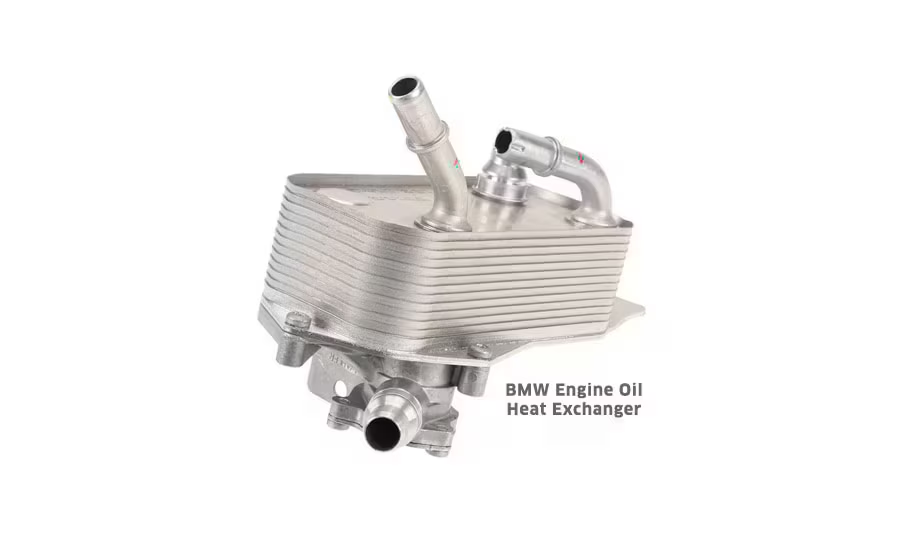
The latest engineering leap is to integrate an intercooler into the intake tract or plenum instead of using a traditional front-mount intercooler. The S55 engine in the M3/M4 was the first BMW to have a heat exchanger mounted in the intake. It's a cooler mounted on top of the engine and is fed from two dedicated radiators in the nose. The B46 4-cylinder and B58 6-cylinder engines evolved this design by further integrating the heat exchanger with the intake manifold, saving packaging space. The location of these top-mount or integrated coolers is ideal because it cools the incoming air before it enters the cylinder head. The placement of the heat exchanger saves space as it doesn't require a large front mount intercooler and associated piping. The cooling fluid supply can come from an existing or small auxiliary radiator but requires a small auxiliary water pump to provide the flow. Mounting the heat exchanger on top of the intake adds a lot of weight above the center of gravity but is necessary for the B46/B58's engine layout.
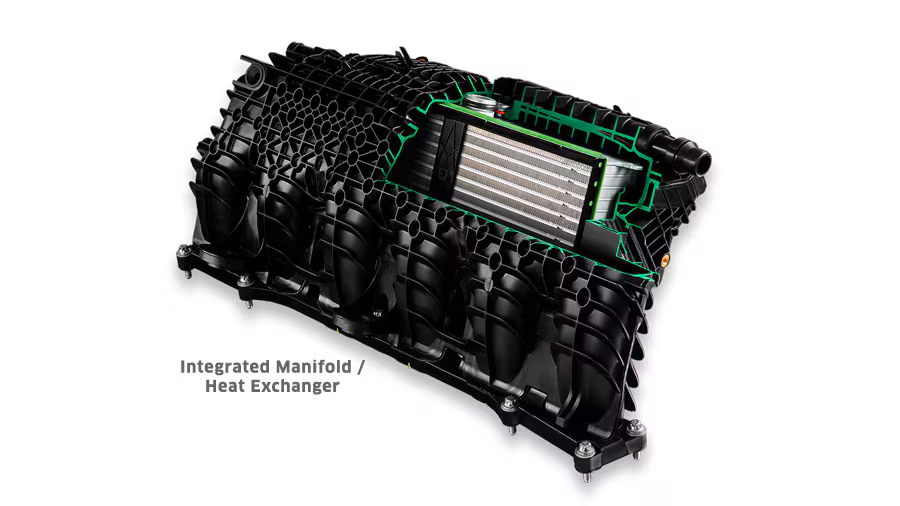
Heatsoak Management
A radiator is only effective at convective cooling when the car is in motion. This airflow over the tubes is the only way the radiator can cool the fluid. That's why all street cars have a fan to provide auxiliary air flow. Older cars have the fan mounted on the water pump shaft and the fan spins all the time. Later cars (around 1999) have a fully electric fan that is triggered by coolant temperature. Once the coolant reaches a certain temperature the fan turns on. An extra threshold might be built in to engage a faster speed. The electric fans are superior especially in heavy traffic where speeds and air flow are low.
Intelligent heat management also applies to newer models with electric water pumps and more sophisticated electronics. The logic built into the engine computer can turn the water pump on or off, depending on the need. Engine temperature is directly related to vehicle efficiency so it may be advantageous to have the engine run hotter than "normal". In that case it doesn't make sense to have a water pump that is engaged all the time. Conversely, the electric pump can also be used to cool and circulate fluid after the engine has turned off. This is especially critical on turbochargers and the BMW systems will circulate coolant through them after shut down. There are also smaller auxiliary water pumps on some models that do the same thing for various systems.
BMW Expansion Tank
The expansion tank is also known as the overflow tank or coolant reservoir. As cooling demands change the level of coolant in this tank will go up or down. It's also a place where coolant can spill into when system pressure is too high. The cap on the tank serves a vital purpose of venting/controlling system pressure. Too much pressure needs to be vented to prevent a failure. Too little pressure leads to poor system performance. For this reason the expansion tank, cap, and bleed valve are the highest points of the cooling system.
The expansion tank on 1992+ models seems to be the most common source of leaks and broken plastic. It must be a material issue or quality control problem that allows the plastic to split or warp and cause leaks. Failures are not an epidemic and they typically last 5-6 years so maybe that's just their expected demise. Unless the car is tracked or raced, most people simply reinstall an OEM plastic tank with the expectation that it will fail and need replacement again in the future. For ultimate reliability, but higher cost, we offer an aluminum expansion tank for some models.
BMW Cooling Hoses
Hoses and connections have evolved from slip fit with a hose clamp to positive-locking types with solid fittings. It used to be common to replace hoses because of a leak or deformed hose. But now the fittings and tolerances between hard parts is so close that leaks are rare. The only time it makes sense is if the quick-disconnect has been used repeatedly and the latch mechanism can no longer provide enough clamping power to secure the hose. Often times you can fix a leak simply by replacing the rubber o-ring seal inside the connector.
BMW Split Cooling System
Starting in 2016-2017 BMW implemented a split cooling strategy to their new engines. Split cooling separates the engine block and the cylinder head(s) to control their temperatures independently. The cylinder head and turbo(s) receives a constant supply of coolant but cooling to the engine block can be reduced or turned off. During a cold-start, warm-up, or normal driving coolant circulates through the cylinder head and turbo but is cut off from the engine block. By re-directing more hot coolant to the head, the engine will warm up faster and reduce cold-start emissions. The system first appeared on the 2016-2017 N63TU2 V8 and was controlled through a valve in the water pump. Separate cooling circuits of varying sizes were run through the engine block. The system was overhauled and became more sophisticated with the B46D/B58D engines for 2019. This version uses an external heat management module with a split cooling valve that controls coolant distribution.
Additional Cooling Demands
Cars are not getting any simpler and its the cooling systems that have had to do more with less. Cars have become more aerodynamic, taking frontal area away from the radiator space. More parts and systems are jammed under the hood which traps heat. Turbochargers generate more heat under the hood too and also require their own cooling and oiling systems. Oil coolers are either air- or water-cooled. Even electronics get their own cooling fans. Below we will briefly detail the various sub-systems that require or receive cooling resources.
Transmission Oil. Nearly all BMW automatic transmissions, and some manuals, get their oil cooled with the help of the engine coolant mix. In most cases there is a heat exchanger that circulates cool fluid around a chamber of transmission oil. The oil is carried to and returned from the heat exchanger by rubber hoses. Coolant is also carried by a different set of hoses, usually from the radiator.
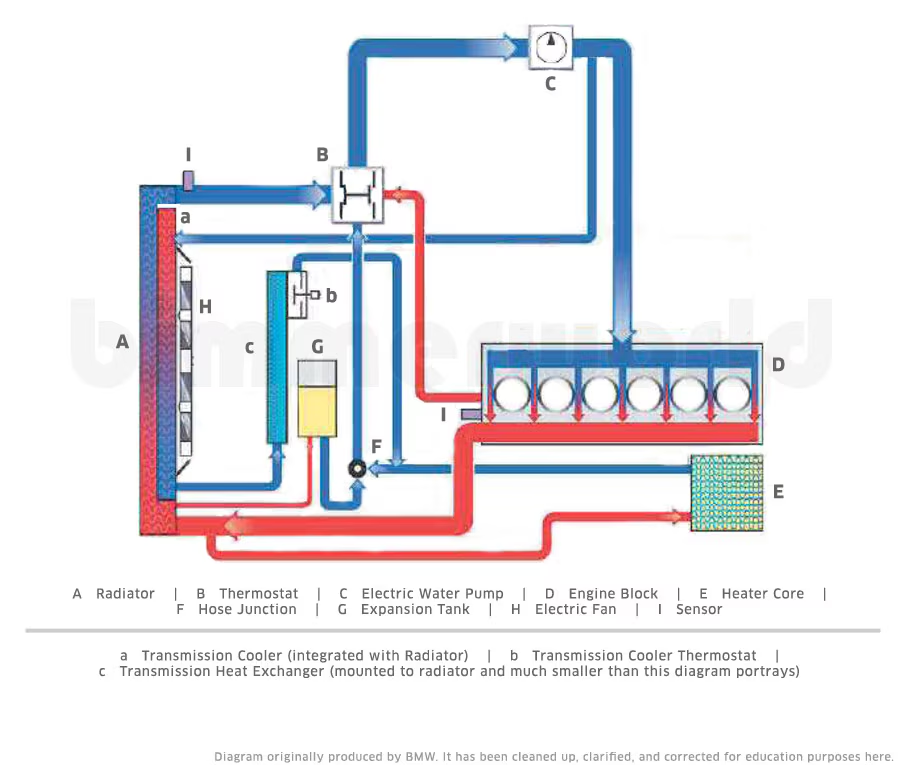
Engine Oil. Most M models and some factory performance options include an engine oil cooler. In older models it's a simple radiator design using oil:air convection. But in other models coolant is used with a heat exchanger, similar to the transmission oil system above.
Turbochargers. The first great wave of factory BMW turbo models appeared in 2007 with the N54 135i/335i/535i. By using exhaust gases (which are already super hot), and then compressing intake air (which turns it hot), a cooling solution is needed on each turbo. BMW turbos get their oil and coolant supply from the engine block through dedicated lines. Cooling demands are managed by the engine computer which will continue pumping coolant through the block and turbos even if the engine is off.
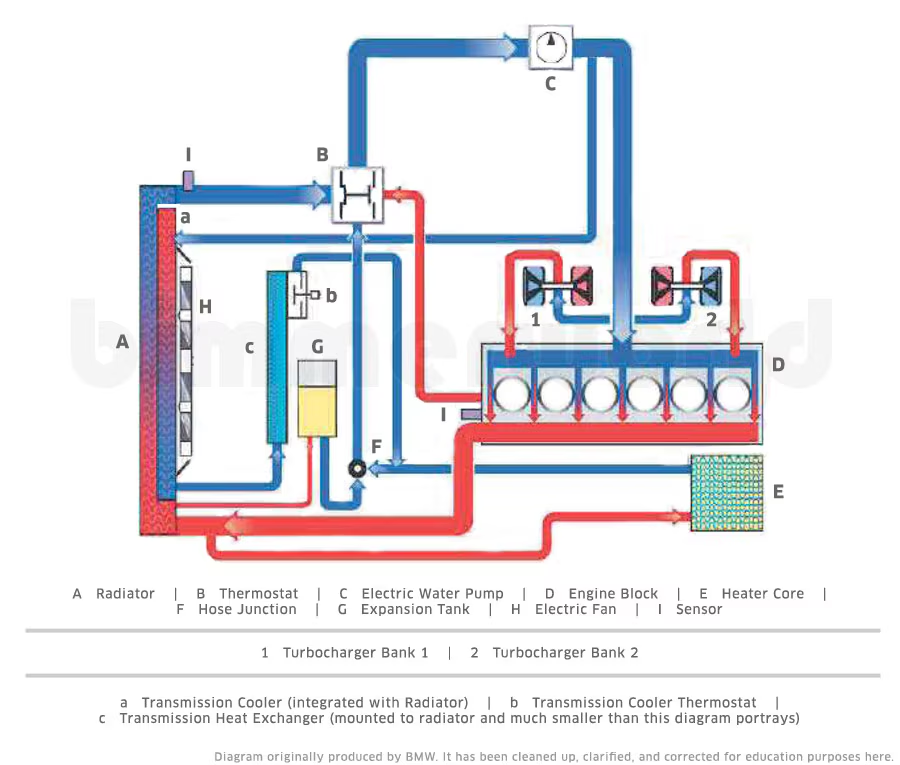
M Sport, Increased Top Speed, or Load Increase. You can't say BMW doesn't take performance seriously. If your car comes with the right combination of options you got one or two additional radiators and an auxiliary water pump, just for additional cooling performance. Options like the M Performance Package or M Sport package added auxiliary coolant radiators in the right or left sides of the nose for added surface area and cooling (some cars have an oil cooler). The M Sport models feature ///M-inspired front spoilers with additional openings just for radiators. It's the perfect example of how important cooling is on these modern BMWs.
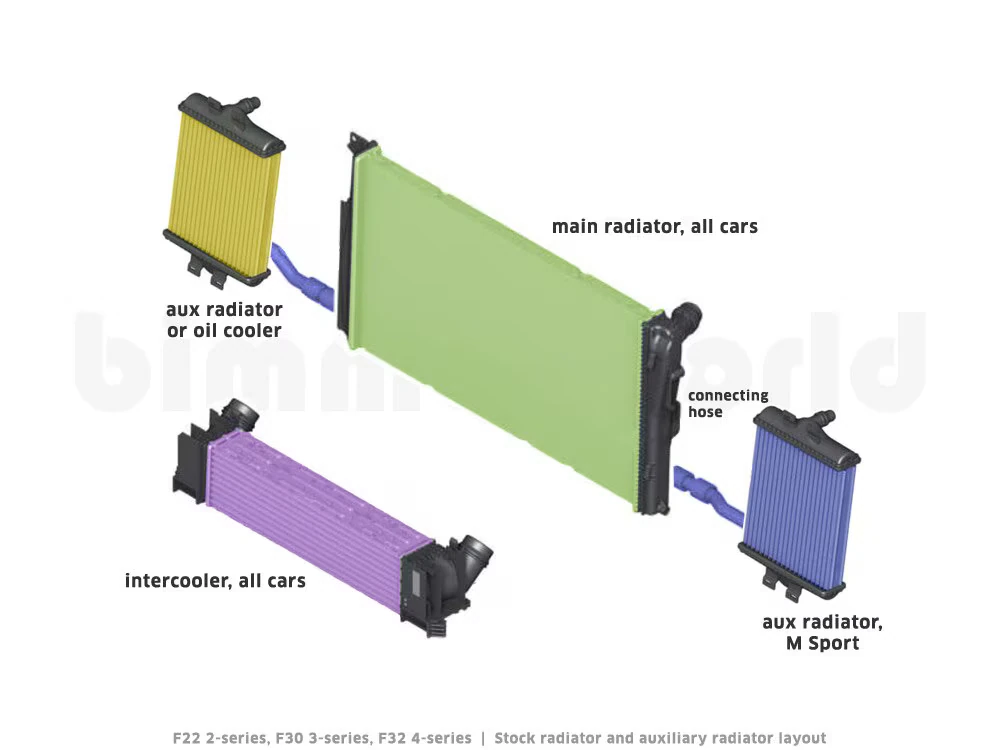
With a few exceptions BMW cooling systems are reliable and up to the task of providing adequate cooling for daily driving. Upgrades exist, mostly to get away from the problematic plastic pieces. Making the cooling system more robust and bulletproof does no harm even if it may be excessive for daily street use. However, aluminum expansion tanks and radiators exist for a reason and that's to address the shortcomings of the original design. In the end your only regret is that you spent too much.
For BimmerWorld, better cooling became a necessity on our F30 328i race cars built for endurance racing in the IMSA Continental Sports Car Challenge. We found that even with the stock turbo it was sustained high temperatures that killed our performance. We petitioned for a bigger turbo on the grounds that the larger turbo was less-stressed and could put out the same power with lower temps but were denied. That required us to really attack the cooling system on the F30 to make it more efficient for hours of continuous racing.
F8X M2/M3/M4 S55 Cooling System
The S55 engine in the F87 M2 Competition, F80 M3, and F82/F83 M4 has very large cooling demands and a new approach to intake air cooling. Not only does each turbo need coolant flow but the intercooler located at the top of the engine also has a coolant circuit. The S55 did away with the more familiar air:air front-mounted intercooler. Like on M Sport models mentioned above the M2/M3/M4 has additional radiators in virtually every opening in the front spoiler. This resulted in 5 or 6 different radiators and heat exchangers (not counting the A/C condenser) spread among 3 or 4 unique cooling circuits. We're not counting the water injection system found in the M4 GTS in this summary.
Engine Cooling (click for diagram) is done via a traditional main engine radiator located in the nose (part #17112284607) as well as a smaller auxiliary radiator in the driver's front wheelwell/spoiler duct (part #17112284603). This is very much like any other M Sport model. Turbo cooling is run from the main engine cooling circuit but with its own small electric water pump.
Air Intake Cooling (click for diagram) also has its own front radiator in the center (aka a heat exchanger, part #17112284608) as well as a smaller auxiliary radiator in the passenger's front wheelwell/spoiler duct (part #17112284604). This circuit also uses an auxiliary water pump to circulate coolant to the top-mount intercooler and back through the radiators. This system has its own expansion tank.
Engine Oil Cooling is done via a air:oil cooler (part #17212284540) underneath the front spoiler and perpendicular to the ground. This is an oil circuit only and does not have coolant passing through it.
DCT Transmission Cooling has its own dedicated cooler (part #17112284503) in front of the intake radiator. This is an oil circuit only and does not have coolant passing through it. The manual transmission does not have an oil cooler.
Each of these is a self-contained cooling circuit with its own hoses. No hoses are shared between circuits. This results in a lot of different hoses, connections, and even extra water pumps and coolant tanks. Leaks can occur just about anywhere, including inside the top-mount intercooler.
F3X 228i/328i/428i N20 Cooling System
While building our cooling catalog we came across the interesting, and confusing, cooling system design of the 2012-2019 N20 engine. This was used in F22 228i, F30 320i/328i, and F32 428i models. The various trim and package options for these cars meant different equipment was used. From racing the N20 engine we already know of the cooling struggle with this platform. Below you will find our notes on the different factory options and how they relate to cooling logic. Please realize these are only notes and open to interpretation and changes as we encounter new info.
Base
Base Model, Manual Transmission - as basic (simple) as it gets. 1 radiator, upper and lower hoses, electric water pump, and thermostat.
Base Model, Auto Transmission - same as the manual but adds a transmission oil heat exchanger which alters the hose layout somewhat. The transmission cooling takes cool coolant from the water pump hose, runs through the heat exchanger, and exits to a radiator. The main 3-point hose for this circuit looks complicated because it also supplies coolant to the heater core.
Sport Line
Sport Line, Manual Transmission - Sport Line (code ZSP) added a second small radiator in the passenger side that added cooling capacity and surface area. The routing of the hoses seems to indicate this benefited the turbo cooling the most. What seems odd to us is the upper radiator hose which would be hot coolant entering the radiator. However, there is a line extending to the small radiator outlet port. So we're not sure if this is hot coolant dumping into cool coolant or cool coolant making its way up a line to mix with hot coolant. Either way it seems this was done to close off the small port on the radiator (left un-used with the aux radiator).
Sport Line, Auto Transmission - same as the manual but adds a transmission oil heat exchanger which alters the hose layout somewhat. Auto transmission coolant passes through the main radiator.
High Speed Synchronization (code 840) - this was a higher top speed matched to summer performance tires. It seems that you can only get High Speed Sync with the Sport Line. But if you ordered all-season tires or 17" wheels the High Speed Sync was taken away. There is no cooling difference compared to Sport Line so this just confuses parts diagrams.
M Sport
M Sport, Manual Transmission - M Sport (code P337) was a large trim package that also added a second auxiliary radiator on the driver side. So now the car has one large main radiator and two small radiators. There is a crossover hose connecting the two aux radiators. The upper radiator hose also has a smaller line that feeds into the radiator that was previously used for auto transmission radiator. That now becomes additional cooling capacity and surface area for engine cooling. The passenger aux cooler seems focused on turbo cooling (as in the Sport Line). The driver aux cooler seems dedicated to auto transmission cooling.
M Sport, Auto Transmission - same as the manual but adds a transmission oil heat exchanger which alters the hose layout somewhat. Auto transmission coolant passes through the driver aux radiator.
BMW 17127609532 vs 17127596839 hose differences. This is the lower coolant hose for automatic transmission models. Base models use the 532 number. Sport and M Sport models use the 839 number. We have inspected these side by side and found no difference between them. They both have 3 connection points (water pump, AT heat exchanger, and heater core) and follow the same layout and even the bends in the hoses are the same or extremely close. Our best guess is that Sport and M Sport cooling components were assembled as a module and BMW needed to separate their inventory for each (that's only a guess though).
BMW Cooling System Diagrams
BMW Cooling Products
| Sort by Name | Sort by Price |



